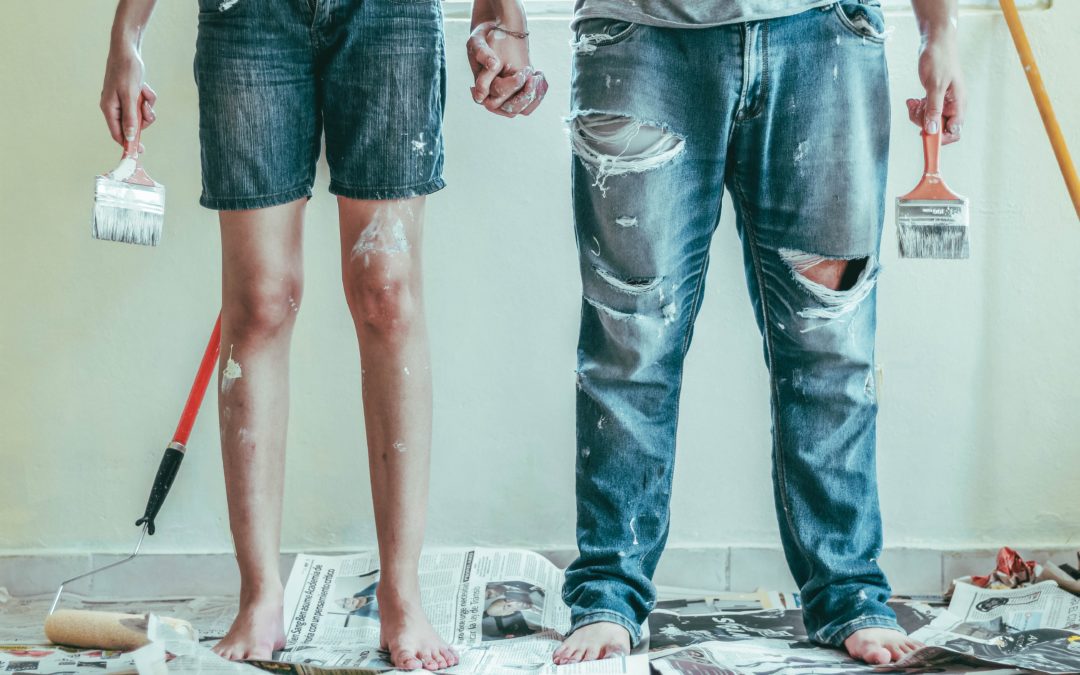It’s not easy to choose between paint or stain options for your cabinets. Both options have several pros and cons, so there’s no one-size-fits-all choice. Here’s what you need to know about these two approaches so you can make the right choice for your home projects.
What Are Painted Cabinets?

Image via roselyntirado free to use under Unsplash
Painted cabinets have a thick coating of opaque paint that completely conceals the material beneath. When cabinets are painted properly, you will not see any grain, but rather a completely smooth, flat surface. Cabinet paint also comes in any color you can dream up. Gray, blue, and black are some popular options but you can let your personality shine and paint cabinets anything from hot pink to hunter green. There are no limits to the type of aesthetic that you can create when you’re working with paint.
What Are Stained Cabinets?
Stained cabinets have a semi-transparent stain applied to the wood. The stain is absorbed into the wood itself so you will still see the grain and any other wood markings. The stain will also change the color of the cabinet slightly, but it won’t make the same dramatic difference as a paint job. Stain is meant to enhance rather than conceal the wood that’s used for the cabinetry. They’re usually brown or tan, but gray-tinted stains are gaining popularity as well.
Pros and Cons of Painted Cabinets
Painting your kitchen cabinets is a quick way to change the room’s overall appearance drastically. If you’re building a custom home, you can use painted cabinets to make a bold statement from day one. Paint may seem like a simple solution, but it has both pros and cons to consider.
Some pros of painted cabinets are:
- Affordability: You can use paint to conceal a lower-quality wood. It’s nearly impossible to tell what’s underneath a good paint job.
- Maintenance: Painted cabinets are easy to clean with a damp cloth, as the smooth finish makes it easy to wipe away stains. The painted finish also makes it easier to see grime and dirt so you’re more likely to remember any maintenance requirements.
- Durability: Paint adds some durability to your cabinets, making them more sturdy than a cabinet with a stain applied.
The cons of painted cabinets include:
- Coverage over the grain: If you’ve invested in beautiful quality wood, a paint will only conceal the elegant look and feel of your material.
- Scratches and dings: If your painted cabinets get damaged, the result is usually quite visible. Chipping or scratched paint will quickly diminish the look of your kitchen.
- Difficult touch-ups: If you need to touch up the cabinets, you’ll have to get the right color and brand match for your paint. The process of removing any blemishes and starting a painting project can be time-consuming and cumbersome.
Pros and Cons of Stained Cabinets
Staining your cabinets is the classic choice. This is a time-honored option that will give any home a traditional look. You can update the appearance of your kitchen with a new stain while still keeping the same wood grain you’ve come to love. If you’re leaning toward stain options instead, there are some important pros and cons to consider.
The main pros of stained cabinets are:
- Visibility of the grain: If you have high-quality cabinets made from a lovely mahogany or cherry, a stain will showcase your investment.
- Ability to hide damage: Scratches and dents hide better on stained cabinets than on painted ones. They can even give a rustic kitchen more character, while the same effect on painted cabinets might look unkempt.
- Easy touch-ups: You can use a simple touch-up marker for stained cabinets. Since the color is uneven anyway, you don’t need an exact product match.
The cons of stained cabinets include:
- Application difficulty: The staining process involves several steps. You must strip and sand the surface to remove any prior finish before applying the stain.
- Visible blemishes: While stain showcases character, it also highlights blemishes. If your cabinets have features in the grain that you don’t want to highlight, you’ll find it hard to conceal them with stain.
- Limited color options: Your color choices are quite limited when it comes to staining cabinetry, as a stain’s chemical makeup creates a subdued appearance.
How To Choose Between Paint and Stain
Both paint and stain are laborious and time-consuming to apply, so you’ll want to consider your options carefully before settling on a choice. Once you’ve committed to paint, it’s difficult (though not impossible) to switch to stain. Painting over an existing stain is slightly easier, so you may want to keep this information in mind if you’re on the fence or may decide to try a different look in the future.
Your home’s overall aesthetic will play a big role in your final decision. Both paint and stain have their strengths and weaknesses, so the choice usually comes down to what looks best. This is an entirely subjective decision. Take some time looking through home decor magazines or websites to get a better feel for how you want the kitchen to look.
A contemporary home typically looks best with painted cabinets. Paint gives you a clean, even surface that’s sure to make a striking impact in the room. It can also convey a minimalist or modern look in a simple, sleek color like black or white. If you prefer a bolder statement, you can use striking pastels like mint green, robin’s egg blue, or sunny yellow for a distinctly retro feel.
If you prefer a more traditionalist look and earthy colors, staining is the obvious choice. Stain also works well in a rustic home environment, such as a get-away cabin in the woods or a kitchen with a cabin aesthetic. This timeless choice is also more versatile if you like to redecorate often.
If you’re interested in starting construction on a new custom home with cabinetry made to your specifications from the beginning, we can help. Contact our team at Steiner Homes in Valparaiso, Indiana, today to learn more about the customizations available for cabinets, flooring, walls, and beyond.

